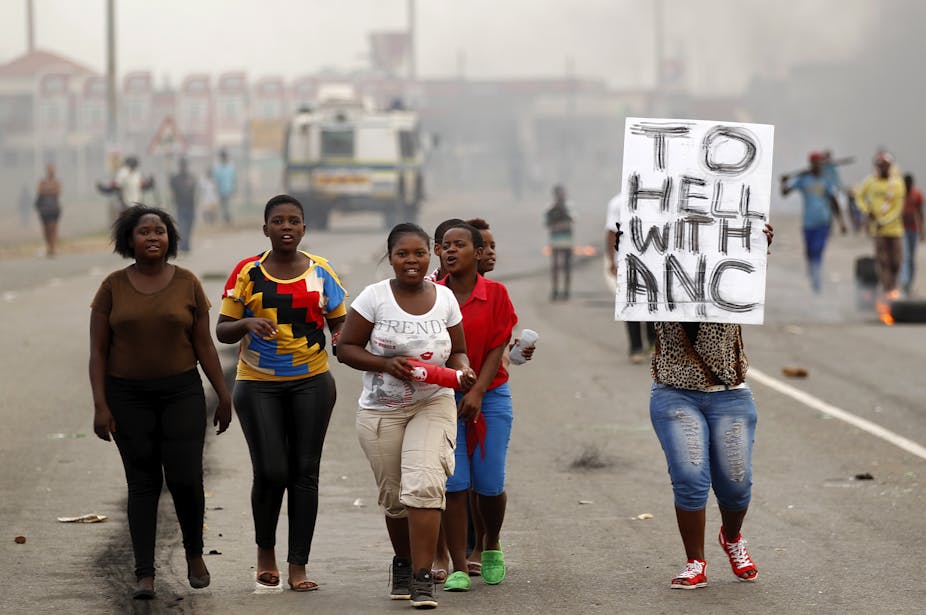It is ironic that South Africa, which only a few years ago was hailed for peacefully overcoming centuries of repression, conflict, bitterness and division, is today the protest capital of the world.
Protests reached unprecedented levels in 2014, peaking at 185 during the year. This came a decade after the first dramatic eruption of protests at the lack of the poor quality basic services in Diepsloot, a sprawling township north of Johannesburg and Harrismith, a large town 300 kms south east of the city, in September 2004.
Since then the country has witnessed an explosion of unrest at local government level with protests shooting up from about 10 a year in 2004 to 111 in 2010, 173 in 2012 and 155 in 2013.
Many of the protests have been accompanied by violence and destruction of property.
During the past year Gauteng province, the country’s economic hub, followed the Eastern Cape and Kwazulu-Natal as the most protest ridden provinces in South Africa.
What’s driving people onto the streets
In most instances the cycle is being sustained by unresolved issues, particularly the slow pace in translating political freedom into tangible benefits for the vast majority of the country’s previously marginalised majority black population.
The protests are typically directed against a local municipality over the lack of services like water and electricity. The spark can also come from a wider range of problems such as inadequate housing as well as public sector corruption.
These tensions are compounded by allegations from more than 10 case studies in areas across South Africa that the state uses dubious tactics to end the protests. Examples include providing protest leaders jobs instead of dealing with the fundamental grievances of communities.
A troubling aspect of the protests is that they often involve extensive damage to government facilities, such as offices and libraries.
This suggests that, faced with the reality that the state is generally unresponsive to demands raised through formal institutional channels, dissatisfied citizens and their organisations have increasingly sought alternative ways to express their grievances.
Communities often eschew formal channels for engagement between the state and civil society. The alternative routes chosen vary from community to community, according to social, economic and political contexts.
Why people feel ignored
Case studies conducted in the Free State, Northern Cape, North West, and Western Cape show that frustrations boil over when communities believe they have been consulted but don’t see any tangible evidence of their inputs.
Every community is able to identify development priorities through locally initiated Integrated Development Plans.
Priorities may include needs like housing, roads and sewage systems, and even the need to address rampant corruption and crime. Once these concerns and priorities are adopted as part of the municipality’s plans, communities expect a timely response to any future grievances they might have.
Protests are also being fuelled by the state`s failure to address the deficit between citizens’ rising expectations and the daily realities of abject poverty, unemployment and inequality.
Some stark figures bear this out. More than 10 million South Africans, or 20.2% of the population, live in extreme poverty. The society is one of the most unequal in the world, with the richest 20% of the population accounting for more than 64% of consumption.
Unemployment remains stubbornly high at 35%, using the expanded definition.
The ruling party has had a part to play
The African National Congress-led government is under intense pressure to change this reality and demonstrate tangible results. But its response has been to swing like a pendulum between reconciling the demands of citizens with the expectations of party members.
To satisfy party members the ANC has given preference to governing party members and acolytes for positions, a practice known as cadre deployment. This has led to a lack of accountability by local government officials. It also often meant that worthy candidates have been overlooked for crucial positions.
With the party acting as the instrument for dispensing patronage it was inevitable that political infighting within the governing party would, inadvertently, also fuel service delivery protests.
It is not a practice the ANC is about to stop. The clearest indication that it will continue employing officials based on their links with the party came in a recent statement by the Premier of the Free State province, Ace Magashule. “We [the ANC] are not ashamed of cadre deployment. We will continue to implement it without fail.”
Steps taken to address the problem
The government has taken several steps to address the daily concerns that give rise to the protests. This includes the establishment of the inter-ministerial service delivery task team. The purpose of this task team is to fast-track service delivery and enable the state to respond quickly to areas that encounter problems.
The appointment of former finance minister Pravin Gordhan as Minister of Cooperative Governance and Traditional Affairs which local government was a step in the right direction. His performance in previous government portfolios has been sterling. This includes being credited with turning the South African Revenue Services into a pocket of excellence.
But to date attempts to deal with problems have been met with widespread disapproval and resistance from municipal officials, who are often ANC members. This has rendered hollow government pronouncements about a commitment to a transparent and accountable local government system.
Gordhan has a tough mountain to climb. His ministry has to tackle nepotism, cadre deployment, rampant corruption, and above all, government officials who are doing business with municipalities.
Will he succeed in his goal of fixing the problems? Pressure will be mounting in the run up to municipal elections next year.
Strong local structures needed
Re-invigorating local governance structures at local level will go a long way in providing communities the much-needed platforms to air their grievances.
As Machado and colleagues correctly argue, where institutions are strong, people are more likely to participate in the political process through formal institution. Where they are weak, protests and other unconventional means of participation become more appealing.

